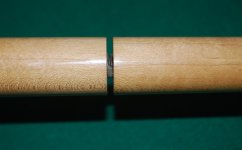Right now I'm repairing an old Mali, with a pilot. The original specs are as follows: shaft has a .524" dia. pilot, but the SS collar has a .560" recess....you tell me what effect the pilot will have...
Piloted joints were originated to compensate for using off the shelf, grade 2 hardware from Rocky's, or any other local hardware store that the cue builder lived near as there was no cue builder supply house back then with precision machined Joint pins., The hardware they bought was as sloppy as a Saturday nite hired girl...... Over time those pilots end up changing, either the wood swells, or shrinks or the brass wears or all the above, and nowadays most of the brand new cues don't even touch from the get go..... and so what is the pilot's job then???? Absolutely nothing. The whole point of a pilot was to align the shaft to the butt on the last few turns because the threading had so much slop, but if 3-5 years after manufacture, they don't even touch, what's the point? Even today, 98% of the cues sold with a pilot, they don't touch the sides of the collar right after being built.
I personally use Tom's modified 3/8 x 10 with the flat minor and use a phenolic insert. Nothing changes with this, and the flat minor ALWAYS aligns the shaft to the butt the same way almost as soon as you start to turn the shaft, and it maintains a firm contact between the shaft and butt.
People can argue til blue in the face that the piloted joint hits better....etc, but really, if it doesn't contact fully into the collar recess, it's just what you may have been brainwashed into believing, IMO.
Dave

